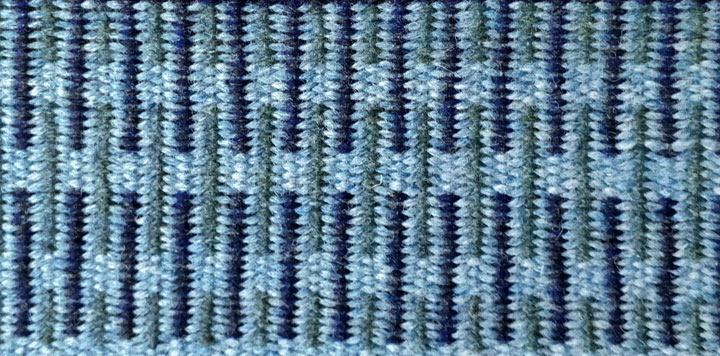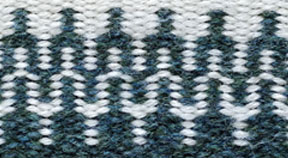Another of the questions I often see on weaving forums is "what do those numbers like 3/2 mean?" When a weaver comes from a background of knitting or crochet where you have names like "laceweight" or "double knitting" it can be confusing to suddenly see patterns asking you to use 8/2 cotton or 2/16 silk or whatever. So what do those numbers mean?
If you buy a rod of metal it is likely to be labelled with the diameter (side to side measurement). Metal doesn't compress when you press it between your fingers, so the diameter is constant unless the rod is processed in some way. Yarn on the other hand is squashy. If you press it between your fingers it compresses to a narrower diameter. So diameter is not the most useful measure for yarn. Instead yarn is gauged, or numbered, by "Yarn count" which can be either a measure of length per unit weight or weight per unit length. These are known as direct and indirect numbering systems. All yarn has a count. It may have a name, but it will have been spun to a particular count.
Yarn counts are complicated because in the past there were no national or international yarn standards so spinners made up their own count systems, so at best you might have a regional count system, but not a national one. There are still a range of count systems, but they can be split into two groups: direct and indirect counts.
Direct yarn numbering system (mass/unit length)
The unit length is fixed and the weight is measured. The measurements are in the form X grammes/Y metres (or in Imperial measurements, X pounds/Y yards).
The international standard measurement for yarn (ISO 1144:2016) is a direct numbering system, using metric measurements and is known as the Tex. The Tex can be used from fibre to yarn and is given in grammes/kilometre (grammes/1000m). It is used for both natural and synthetic fibres.
Under the direct numbering system the larger the number, the thicker the yarn (for a given fibre), because for the same length of yarn there is more weight, so it must be thicker.
For example Tex 30 means each length of 1,000 metres is 30 grammes of weight. For Tex 100, a length of 1,000 metres has 100 grammes of weight. Tex is a logical system. If the Tex number is doubled, the yarn is twice as thick.
Another common direct numbering system is the denier. The denier was based on a strand of silk. Nine hundred metres of single strand silk weighs about one gramme. Denier is often associated with the sheerness of tights or stockings, perhaps because these were made from silk prior to developments in synthetic fibres.
Indirect yarn numbering system (length/unit mass)
The unit weight is fixed and the length is measured. The measurements are in the form X metres/Kg (or in Imperial units, X yards/pound).
Under the indirect numbering system the larger the number, the thinner the yarn (for a given fibre), because for the same weight of yarn there is more length, so it must be thinner (like rolling out a sausage of plasticine).
Common indirect count systems are shown in the table.
English Cotton Count (Ne) is a commonly used system. The yarn count number indicates the “number of 840 yard hanks of yarn per 1 pound weight”.
For example,
Ne 1 – In one pound of yarn weight, there are 840 yards of yarn.
Ne 5 – In one pound of yarn weight, there are 4200 (840x5) yards of yarn.
What's that? Your yarn is plied? Oh my. How does that fit with the count systems?
Strand number
It was very tempting to use the word "ply" as a title for this section, but "ply" comes with its own confusion - like 4 ply yarn that isn't made up of four strands. What's that all about? Maybe I'll get back to that...
A full count system has two numbers: the count number itself and the number of strands that are twisted together to form the yarn. So, strictly speaking a "single" would have a 1 as part of its description, to indicate one strand of yarn.
Cotton count (Ne) and metric (Nm) count tend to have the count number first, so 30/1 cotton (1 means single yarn) indicates that 30 x 840 yards of single strand yarn weigh 1 pound.
But what about something labelled 40/2? Taking the count number first. There are forty lots of 840 yards per pound of yarn so if this were single strand there would be 33600 yards of yarn. But, this is a 2 strand/ply yarn, so two strands are twisted together, making the yarn fatter. If the yarn is fatter it must be shorter (for the same weight) so the resultant count is 40/2 = 20. That means there would be 20 x 840 = 16800 yards of yarn in 1 pound weight.
For inkle weaving I like to use mercerised (aka perle) cotton. Common sizes for that are 3/2, 5/2 and 8/2. The 8/2 is the finest (a resultant count of 4), so 4 x 840 = 3,360 yards/pound. 3/2 (a resultant count of 1.5) so 1.5 x 840 = 1,260 yards/pound. Shorter length = fatter yarn.
Other systems have the numbers the other way around, so 2/30 would be 2 strands of 30 count yarn plyed together weighs one pound, which gives an overall count of 15.
Direct count systems, such as Tex or Denier, tend to have a single number, such as 60 denier of 40 Tex.
This page has a useful description of the many, many yarn counts.
This page contains a link to a chart containing many yarns used for weaving. It contains both the yards/pound and metres/kg data for a range of yarn types ans sizes. You can use the information to help find an equivalent yarn for a project. Maybe I'll write a blog about how to use the data another time.
As I said at the beginning, yarn count is a complicated business. I've barely scratched the surface here. I haven't really answered the question of how to compare knitting/crochet yarn with these count systems so perhaps that will be a toic for another time.
Note:
As a good scientist, I should point out that where I've used the word "weight" I am referring to the colloquial term, used when we "weigh" ourselves, some apples, our yarn, etc. For accuracy, I should of course have used the word "mass" but I figured that would add an extra layer of complication for those who maybe didn't have a science teacher who hammered home the difference.






















